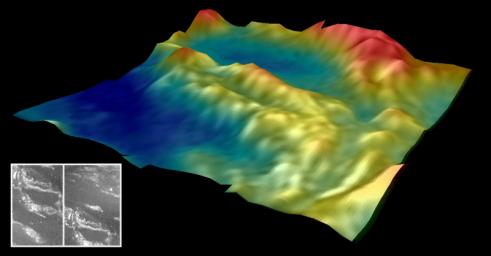Cassini Mission to Saturn and its Moons
 NASA /
JPL
NASA /
JPL
Go to Cassini Update page
 NASA/Jet
Propulsion Laboratory (JPL) false color image showing dark plains on the surface
of Titan. Titan is one of the 36 known moons orbiting the planet Saturn. Surface
features shown are approximately 3 miles (5 km) from the Huygens probe's landing
site. The image was obtained from digital data gathered as the Huygens module
descended from orbit to Titan's surface on 14 Jan 2005.
NASA/Jet
Propulsion Laboratory (JPL) false color image showing dark plains on the surface
of Titan. Titan is one of the 36 known moons orbiting the planet Saturn. Surface
features shown are approximately 3 miles (5 km) from the Huygens probe's landing
site. The image was obtained from digital data gathered as the Huygens module
descended from orbit to Titan's surface on 14 Jan 2005.
The above image was released by the JPL on 01 December 2005.
The false color image is a stereo representation of Titan's surface showing changes in altitude with changing color. The resolution is approximately 45 ft/pixel (14 m/pixel).
The blue color depicts the lowest altitude and red has the greatest altitude.
The red ridges in the center are approx. 150 ft (50 m) high
| Cassini Status |
|
|
|
||||||
|
|
|
||||||
|
||||||
|
||||||
|
||||||
|
||||||
|
||||||
|
||||||
|
![]()
From UA News Services, 520-621-1877, Writer - Agnieszka Baier
This article is from a news release dated 07 Dec 2002. The article is quoted from the News Release Disseminated by NASA's Jet Propulsion Laboratory.
December 7, 2002 Reference Titan ( A Saturn Moon )
"Enshrouded in an atmosphere impenetrable to the visible light, Saturn's largest moon has never revealed its surface. No one has been able to see through the orange-brown atmospheric haze and admire the unknown world below."
"Still, researchers know that Titan is a planet-size organic reactor where "building blocks" of life are being generated as they might have been created 4 billion years ago on Earth."
"In some ways, Titan resembles early Earth. Its dense atmosphere is mostly composed of nitrogen and some methane. Scientists once believed that early Earth's atmosphere was reducing like Titan's and that it allowed fast assembly of long organic molecules. Today many argue that Earth's primordial atmosphere contained nitrogen and a lot of carbon dioxide."
"This type of atmosphere is neutral for oxidation and reduction reactions and does not allow an easy and direct formation of long chains of organic molecules," says University of Arizona planetary sciences Professor Jonathan I. Lunine. "Some particular circumstances may be required to create them.
Although there isn't much carbon dioxide on Titan, if we see that complex organic molecules are created on Titan, it would be a very important lesson about the early Earth and the environment in which life originated."
--------------------------------------------
Contact Information
Jonathan Lunine
520-621-2789 jlunine@lpl.arizona.edu
--------------------------------------------
"Titan has organics, but in what form and how much is not clear.
These molecules are generated in the atmosphere and over time
are deposited on the moon's surface. Until recently, researchers
have been very careful in their speculations about what might be
happening after these molecules get to the surface of Titan,"
Lunine says."
"The atmospheric pressure at Titan's surface is 50 percent higher
than on Earth, which is pressure comparable with pressure at the
bottom of a 10-foot-deep swimming pool. Titan's thick
atmosphere protects the surface and organics from harmful
cosmic rays and ultraviolet radiation."
"The NASA Cassini spacecraft launched in 1997 with the
mission to study
 Saturn and its
moons will reach its target in
Saturn and its
moons will reach its target in
2004. It carries the European
Space Agency's Huygens probe,
which will descend through Titan's
atmosphere and land on the surface.
The Cassini-Huygens mission will
conduct a 4-year survey of Titan's
surface and atmosphere through
remote sensing and in-situ techniques."
RIGHT: Artist Conception of Cassini Space Craft NASA
"The Cassini mission has the potential to teach us as much about
Titan as we know about Mars today. We will learn about the
surface composition, find out more about the atmosphere, and
 see what the
surface looks like. The Cassini orbiter will
measure
see what the
surface looks like. The Cassini orbiter will
measure
the shape of Titan's gravitational field, which will help determine
the nature of Titan's interior," Lunine says."
Image ABOVE: Insertion of Cassini into Saturn's orbit
"Titan will be full of surprises. One of them will be organic
chemistry processes on the surface. It would be interesting to see
what their products might be," he adds. "I also hope that
Cassini-Huygens will tell us if there are places on Titan where the
organic molecules look different, and therefore, might be
modified over time. Particularly exciting would be finding out if
there are any variations in the apparent organic composition that
are correlated with impact carters or sites of volcanism. If that
turns out to be true, these should be the places to visit in the
future," he says."
"Could Titan host primitive life? "It is not the right place, it is
too cold," Lunine says." NASA / JPL
Go to Cassini Update page